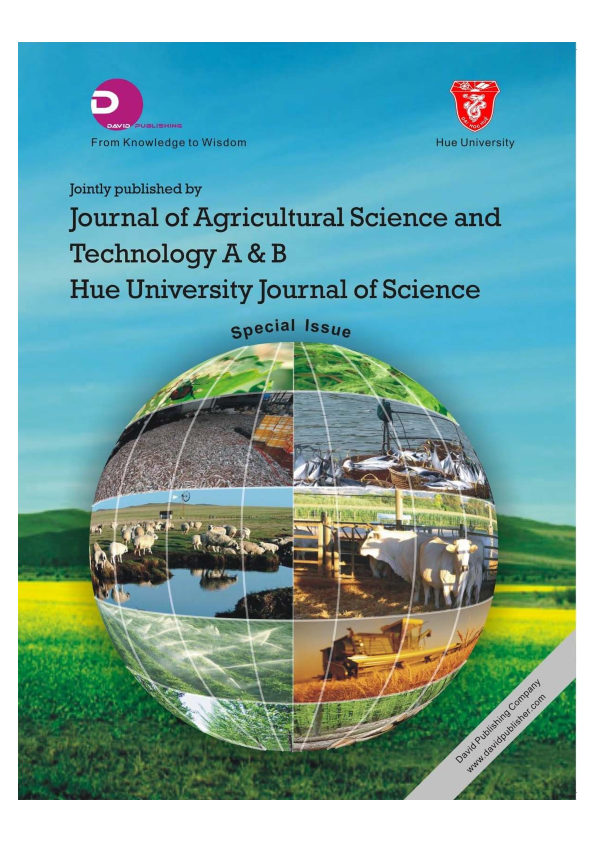Study in Biological Features of Giant trevally(caranx iginoblis) in Tam Giang - Cau Hai lagoon systems, Vietnam
Abstract
Biological characterists and distribution of Giant trevally (Caranx iginoblis) in Tam Giang - Cau Hai lagoon systems, Vietnam showed that the species appeared in lagoon since 2005 and farmers start raising by cages at Tu Hien estaury for well-growing and best market to consumers, there were distributed of the fingerlings from estuaries into lagoon from October to December though inlets, so fishermen can collect every year by bottom nets and enclosed net. Fish are growing faster than other species but not sustainable growing in cages. Beside of this, wild fish can be collected at estuaries with averaed of the body weight 1.99 kg ± 1.22 kg and length 45.66 ± 17.56 cm. The species are big mouth and contained sharp teeth. There are flat body and and head lengt, pectoral fin rays, dorsal and anal yellow, gray dorsal, ventral surface is silver white. They adapted in water environmental conditions of pH (7.1 - 8.5), DO (2.7 - 4.5 mg/l), salinity (17.0 - 33.3 ‰) and temperatures (16.8 - 32.50C). Exposing of the reproductive performance of 50 fish samples were detected the mature females with male fish eggs or refined. Results slices and gonads in stage 1 and 2. The germplasm is a special source of valuable genes of the species.
Keywords: Giant trevally, lagoon, biological features, distribution
References
IMOLA/FAO.2007. Report on the survey and inventory activities and aquaculture operators (with the support of geographic information system). Within the framework IMOLA/FAO ..
Pham Thanh Liem, Tran Dinh Trac.2004. Curriculum biological research methods fish Can Tho University.
Vo Van Phu.1979. The method of biological research of tropical fish bones, document translated from the Russian language - Issues Research ichthyologist, her face and, Volume 20, 21.
Pravdin, I.F. 1973. Guide to study fish, Pham Thi Minh Giang Translation Publishing House of Science and Technology, Hanoi.
Froese, Rainer and Pauly, Daniel, eds. 2009. Caranx ignobilis, FishBase September 2009 version.
Theresa M, Mutia. 2011. Induced breeding of malipulo Caranx ignobilis, NFRDI Fisheries Biolgical Research Centre, Butong, Taal, Batangas.
Froese, Rainer and Pauly, Daniel, eds. (2009). "Caranx ignobilis" in FishBase. S tember 2009 version.
Francisco A. S., Joh L. M., Miriam C. B. and Daniel P. (1996). Biology, Fisheries and Culture of Tropical Groupers and Snappers. ICLARM and EPOMEX. 448pp.
Kirk Murakami1, Shelley A. James2, John E. Randall3,*, and Arnold Y. Suzumoto. 2007. Two Hybrids of Carangid fishes of the Genus Caranx, C. ignobilis x C. melampygus and C. melampygus x C. sexfasciatus, from the Hawaiian Islands. Zoological Studies 46(2): 186-193 (2007).
Smith, G.C. 1992. Occurrence and diets of juvenile Caranx ignobilis and Caranx melampygus (Teleostei: Carangidae) in the Hanalei River estuary, north Kauai, Hawaii. Pacific Science 46(1):103. (Abstract)
Smith, G.C. and J.D. Parrish. 2002. Estuaries as nurseries for the jacks Caranx ignobilis and Caranx melampygus (Carangidae) in Hawaii. Estuarine, Coastal and Shelf Science 55(3):347-359.
Sudekum, A.E. 1982. Notes on the biology and feeding habits of Caranx ignobilis and Caranx melampygus in the Northwestern Hawaiian Islands. Pacific Science 36(4):515. (Abstract)
Smith, G.C. 1991. Abundance, diet, and growth of Caranx ignobilis and Caranx melampygus (Carangidae) in the Hanalei River estuary, North Kauai, Hawaii. M.S. Thesis. 71 pp.
Amarasinghe U.S., I.U. Wickramaratne and M.J.S. Wijeyaratne. 2011. Hook Selectivity of Giant Trevally (Caranx ignobilis) and Nakedbreast Trevally (Carangoides gymnostethus) (Carangidae) caught in the hook-and-line fishery off Negombo, Sri Lanka. Sri Lanka J. Aquat. Sci. 16 (2011): 11-26.
Theresa M. Mutia. 2014. Induced breeding of maliputo Caranx. NFRDI Fisheries Biological Research Centre, Butong, Taal, Batangas, 2014.

